Does NATO Have A Future?
VerifiedAdded on 2023/04/20
|11
|3505
|270
AI Summary
This article discusses the future prospects of NATO in the changing global scenario. It explores the challenges faced by the organization and analyzes potential strategies to ensure its relevance and effectiveness. The article also examines the role of NATO in maintaining peace and stability in the Atlantic region.
Contribute Materials
Your contribution can guide someone’s learning journey. Share your
documents today.
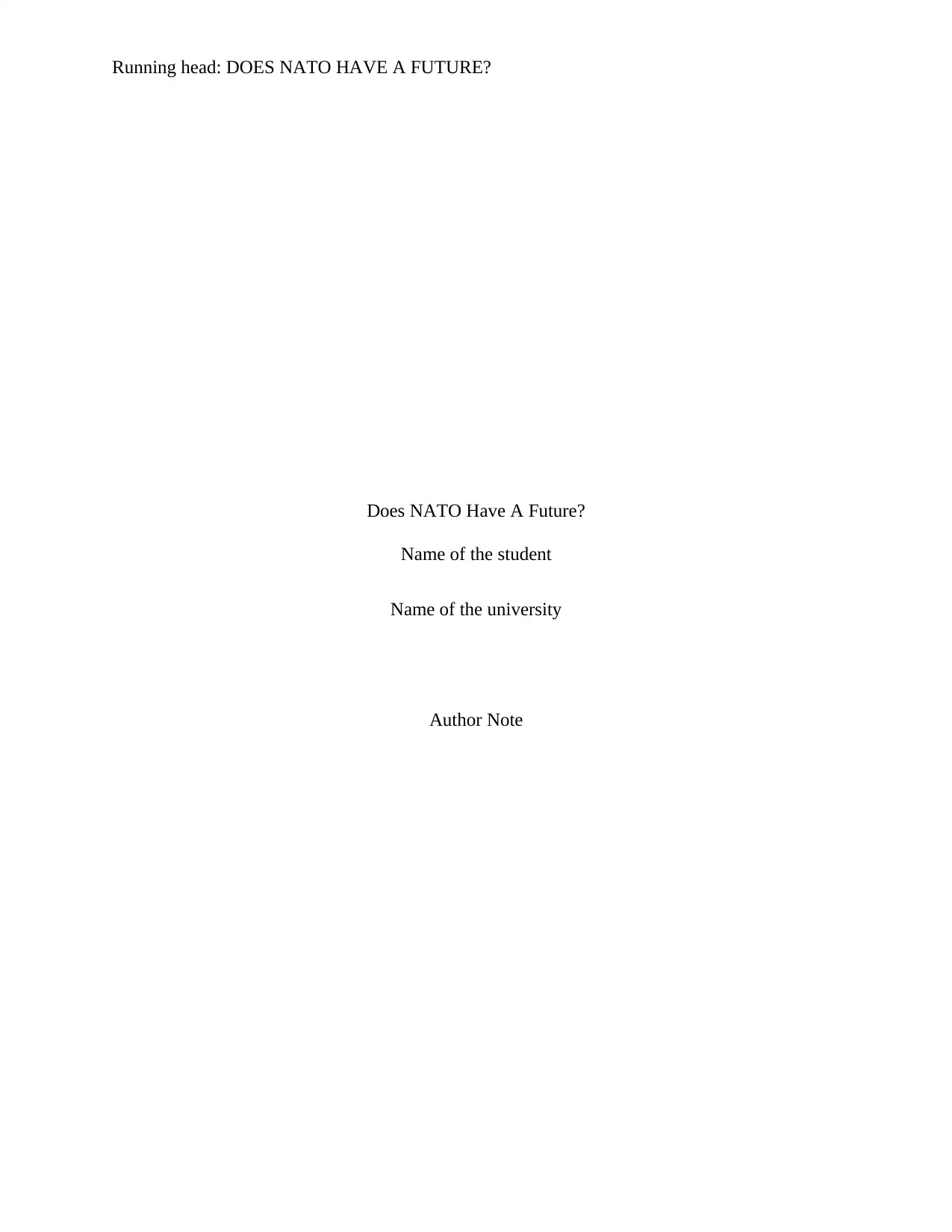
Running head: DOES NATO HAVE A FUTURE?
Does NATO Have A Future?
Name of the student
Name of the university
Author Note
Does NATO Have A Future?
Name of the student
Name of the university
Author Note
Secure Best Marks with AI Grader
Need help grading? Try our AI Grader for instant feedback on your assignments.
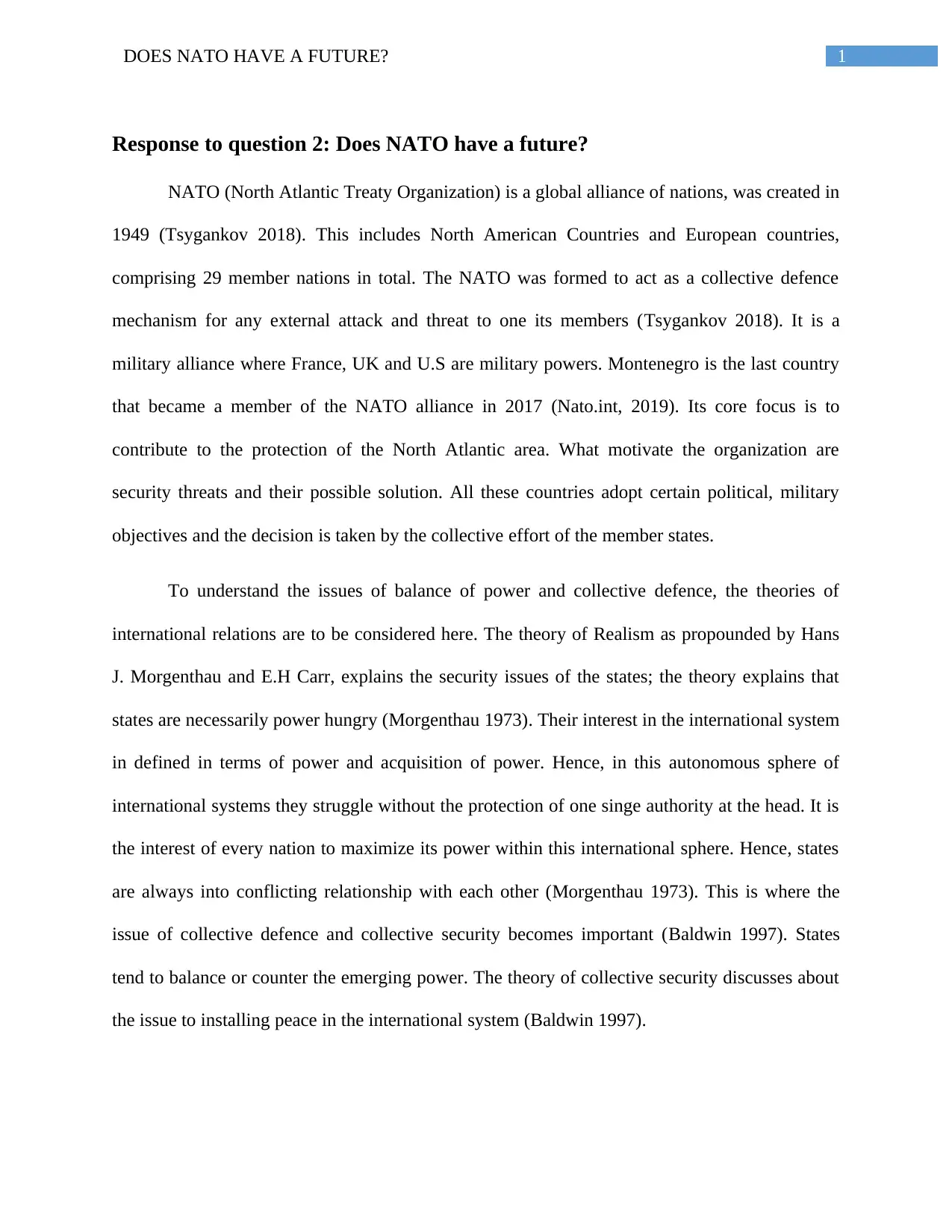
1DOES NATO HAVE A FUTURE?
Response to question 2: Does NATO have a future?
NATO (North Atlantic Treaty Organization) is a global alliance of nations, was created in
1949 (Tsygankov 2018). This includes North American Countries and European countries,
comprising 29 member nations in total. The NATO was formed to act as a collective defence
mechanism for any external attack and threat to one its members (Tsygankov 2018). It is a
military alliance where France, UK and U.S are military powers. Montenegro is the last country
that became a member of the NATO alliance in 2017 (Nato.int, 2019). Its core focus is to
contribute to the protection of the North Atlantic area. What motivate the organization are
security threats and their possible solution. All these countries adopt certain political, military
objectives and the decision is taken by the collective effort of the member states.
To understand the issues of balance of power and collective defence, the theories of
international relations are to be considered here. The theory of Realism as propounded by Hans
J. Morgenthau and E.H Carr, explains the security issues of the states; the theory explains that
states are necessarily power hungry (Morgenthau 1973). Their interest in the international system
in defined in terms of power and acquisition of power. Hence, in this autonomous sphere of
international systems they struggle without the protection of one singe authority at the head. It is
the interest of every nation to maximize its power within this international sphere. Hence, states
are always into conflicting relationship with each other (Morgenthau 1973). This is where the
issue of collective defence and collective security becomes important (Baldwin 1997). States
tend to balance or counter the emerging power. The theory of collective security discusses about
the issue to installing peace in the international system (Baldwin 1997).
Response to question 2: Does NATO have a future?
NATO (North Atlantic Treaty Organization) is a global alliance of nations, was created in
1949 (Tsygankov 2018). This includes North American Countries and European countries,
comprising 29 member nations in total. The NATO was formed to act as a collective defence
mechanism for any external attack and threat to one its members (Tsygankov 2018). It is a
military alliance where France, UK and U.S are military powers. Montenegro is the last country
that became a member of the NATO alliance in 2017 (Nato.int, 2019). Its core focus is to
contribute to the protection of the North Atlantic area. What motivate the organization are
security threats and their possible solution. All these countries adopt certain political, military
objectives and the decision is taken by the collective effort of the member states.
To understand the issues of balance of power and collective defence, the theories of
international relations are to be considered here. The theory of Realism as propounded by Hans
J. Morgenthau and E.H Carr, explains the security issues of the states; the theory explains that
states are necessarily power hungry (Morgenthau 1973). Their interest in the international system
in defined in terms of power and acquisition of power. Hence, in this autonomous sphere of
international systems they struggle without the protection of one singe authority at the head. It is
the interest of every nation to maximize its power within this international sphere. Hence, states
are always into conflicting relationship with each other (Morgenthau 1973). This is where the
issue of collective defence and collective security becomes important (Baldwin 1997). States
tend to balance or counter the emerging power. The theory of collective security discusses about
the issue to installing peace in the international system (Baldwin 1997).
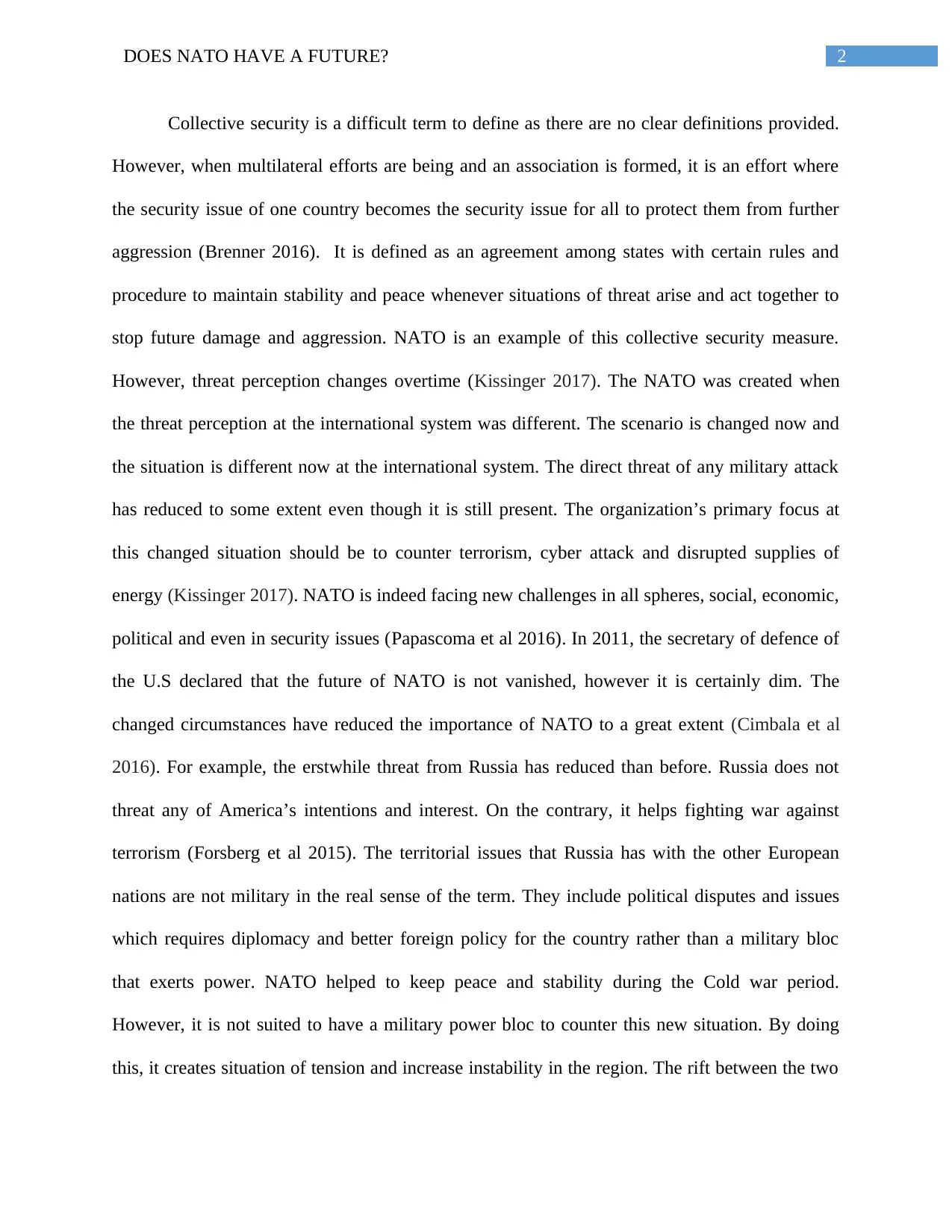
2DOES NATO HAVE A FUTURE?
Collective security is a difficult term to define as there are no clear definitions provided.
However, when multilateral efforts are being and an association is formed, it is an effort where
the security issue of one country becomes the security issue for all to protect them from further
aggression (Brenner 2016). It is defined as an agreement among states with certain rules and
procedure to maintain stability and peace whenever situations of threat arise and act together to
stop future damage and aggression. NATO is an example of this collective security measure.
However, threat perception changes overtime (Kissinger 2017). The NATO was created when
the threat perception at the international system was different. The scenario is changed now and
the situation is different now at the international system. The direct threat of any military attack
has reduced to some extent even though it is still present. The organization’s primary focus at
this changed situation should be to counter terrorism, cyber attack and disrupted supplies of
energy (Kissinger 2017). NATO is indeed facing new challenges in all spheres, social, economic,
political and even in security issues (Papascoma et al 2016). In 2011, the secretary of defence of
the U.S declared that the future of NATO is not vanished, however it is certainly dim. The
changed circumstances have reduced the importance of NATO to a great extent (Cimbala et al
2016). For example, the erstwhile threat from Russia has reduced than before. Russia does not
threat any of America’s intentions and interest. On the contrary, it helps fighting war against
terrorism (Forsberg et al 2015). The territorial issues that Russia has with the other European
nations are not military in the real sense of the term. They include political disputes and issues
which requires diplomacy and better foreign policy for the country rather than a military bloc
that exerts power. NATO helped to keep peace and stability during the Cold war period.
However, it is not suited to have a military power bloc to counter this new situation. By doing
this, it creates situation of tension and increase instability in the region. The rift between the two
Collective security is a difficult term to define as there are no clear definitions provided.
However, when multilateral efforts are being and an association is formed, it is an effort where
the security issue of one country becomes the security issue for all to protect them from further
aggression (Brenner 2016). It is defined as an agreement among states with certain rules and
procedure to maintain stability and peace whenever situations of threat arise and act together to
stop future damage and aggression. NATO is an example of this collective security measure.
However, threat perception changes overtime (Kissinger 2017). The NATO was created when
the threat perception at the international system was different. The scenario is changed now and
the situation is different now at the international system. The direct threat of any military attack
has reduced to some extent even though it is still present. The organization’s primary focus at
this changed situation should be to counter terrorism, cyber attack and disrupted supplies of
energy (Kissinger 2017). NATO is indeed facing new challenges in all spheres, social, economic,
political and even in security issues (Papascoma et al 2016). In 2011, the secretary of defence of
the U.S declared that the future of NATO is not vanished, however it is certainly dim. The
changed circumstances have reduced the importance of NATO to a great extent (Cimbala et al
2016). For example, the erstwhile threat from Russia has reduced than before. Russia does not
threat any of America’s intentions and interest. On the contrary, it helps fighting war against
terrorism (Forsberg et al 2015). The territorial issues that Russia has with the other European
nations are not military in the real sense of the term. They include political disputes and issues
which requires diplomacy and better foreign policy for the country rather than a military bloc
that exerts power. NATO helped to keep peace and stability during the Cold war period.
However, it is not suited to have a military power bloc to counter this new situation. By doing
this, it creates situation of tension and increase instability in the region. The rift between the two
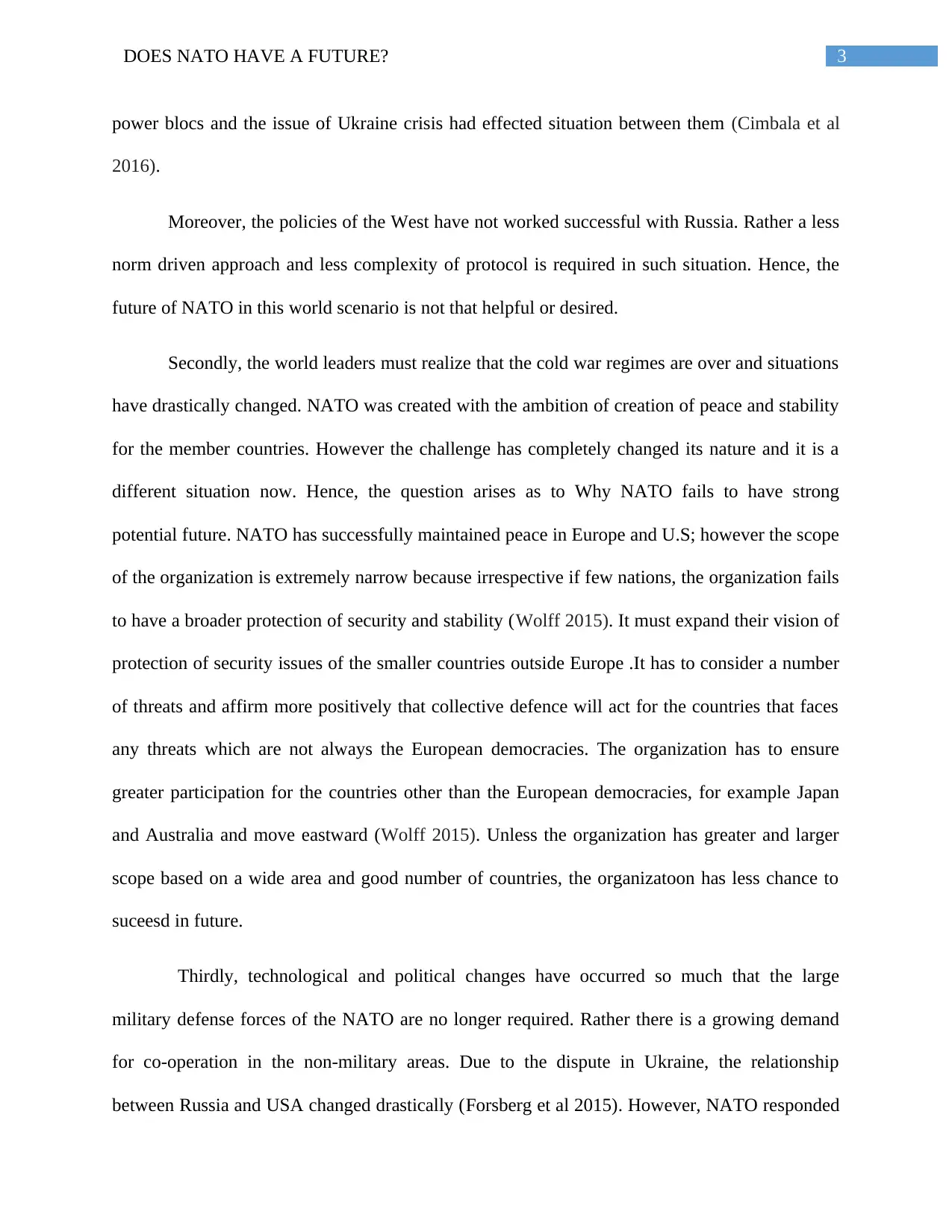
3DOES NATO HAVE A FUTURE?
power blocs and the issue of Ukraine crisis had effected situation between them (Cimbala et al
2016).
Moreover, the policies of the West have not worked successful with Russia. Rather a less
norm driven approach and less complexity of protocol is required in such situation. Hence, the
future of NATO in this world scenario is not that helpful or desired.
Secondly, the world leaders must realize that the cold war regimes are over and situations
have drastically changed. NATO was created with the ambition of creation of peace and stability
for the member countries. However the challenge has completely changed its nature and it is a
different situation now. Hence, the question arises as to Why NATO fails to have strong
potential future. NATO has successfully maintained peace in Europe and U.S; however the scope
of the organization is extremely narrow because irrespective if few nations, the organization fails
to have a broader protection of security and stability (Wolff 2015). It must expand their vision of
protection of security issues of the smaller countries outside Europe .It has to consider a number
of threats and affirm more positively that collective defence will act for the countries that faces
any threats which are not always the European democracies. The organization has to ensure
greater participation for the countries other than the European democracies, for example Japan
and Australia and move eastward (Wolff 2015). Unless the organization has greater and larger
scope based on a wide area and good number of countries, the organizatoon has less chance to
suceesd in future.
Thirdly, technological and political changes have occurred so much that the large
military defense forces of the NATO are no longer required. Rather there is a growing demand
for co-operation in the non-military areas. Due to the dispute in Ukraine, the relationship
between Russia and USA changed drastically (Forsberg et al 2015). However, NATO responded
power blocs and the issue of Ukraine crisis had effected situation between them (Cimbala et al
2016).
Moreover, the policies of the West have not worked successful with Russia. Rather a less
norm driven approach and less complexity of protocol is required in such situation. Hence, the
future of NATO in this world scenario is not that helpful or desired.
Secondly, the world leaders must realize that the cold war regimes are over and situations
have drastically changed. NATO was created with the ambition of creation of peace and stability
for the member countries. However the challenge has completely changed its nature and it is a
different situation now. Hence, the question arises as to Why NATO fails to have strong
potential future. NATO has successfully maintained peace in Europe and U.S; however the scope
of the organization is extremely narrow because irrespective if few nations, the organization fails
to have a broader protection of security and stability (Wolff 2015). It must expand their vision of
protection of security issues of the smaller countries outside Europe .It has to consider a number
of threats and affirm more positively that collective defence will act for the countries that faces
any threats which are not always the European democracies. The organization has to ensure
greater participation for the countries other than the European democracies, for example Japan
and Australia and move eastward (Wolff 2015). Unless the organization has greater and larger
scope based on a wide area and good number of countries, the organizatoon has less chance to
suceesd in future.
Thirdly, technological and political changes have occurred so much that the large
military defense forces of the NATO are no longer required. Rather there is a growing demand
for co-operation in the non-military areas. Due to the dispute in Ukraine, the relationship
between Russia and USA changed drastically (Forsberg et al 2015). However, NATO responded
Secure Best Marks with AI Grader
Need help grading? Try our AI Grader for instant feedback on your assignments.
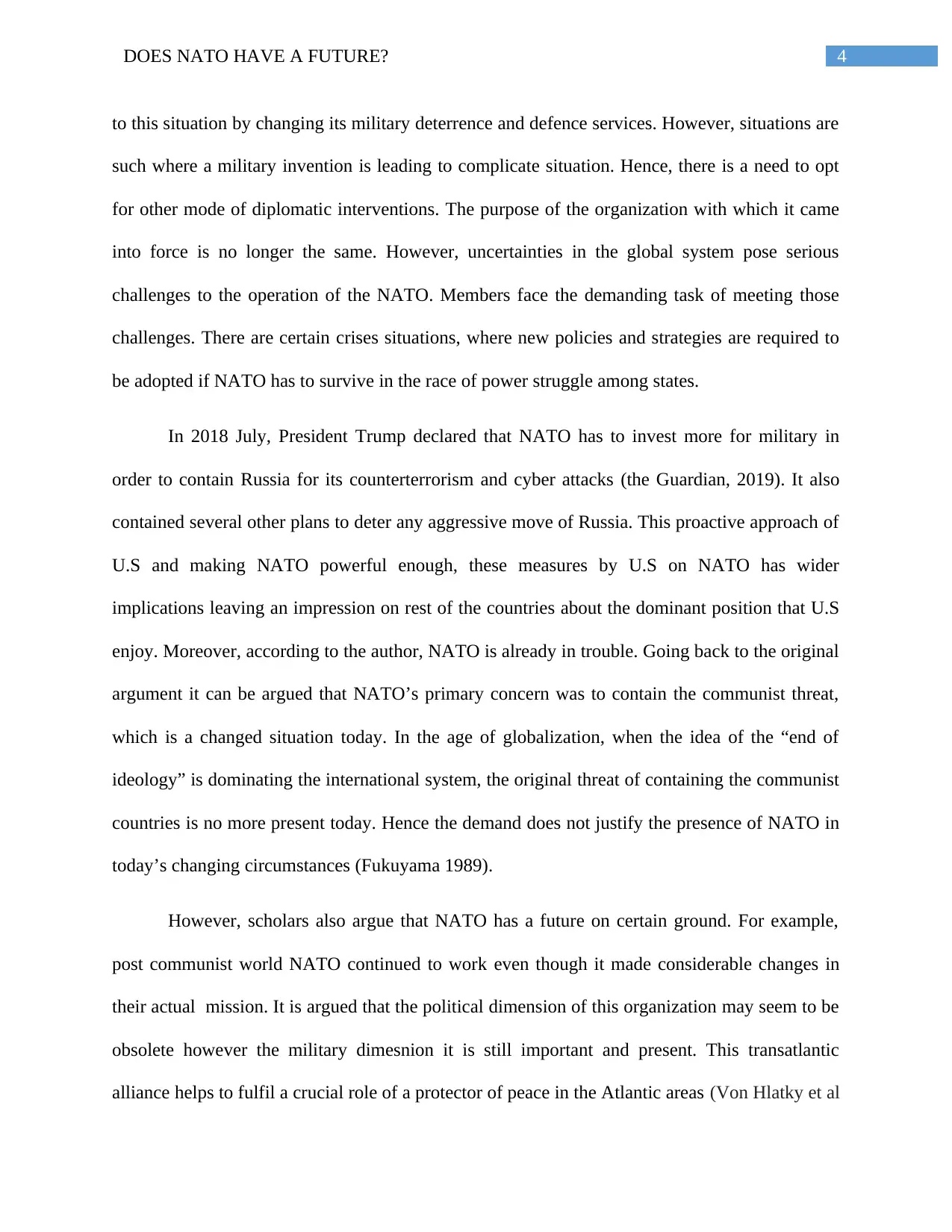
4DOES NATO HAVE A FUTURE?
to this situation by changing its military deterrence and defence services. However, situations are
such where a military invention is leading to complicate situation. Hence, there is a need to opt
for other mode of diplomatic interventions. The purpose of the organization with which it came
into force is no longer the same. However, uncertainties in the global system pose serious
challenges to the operation of the NATO. Members face the demanding task of meeting those
challenges. There are certain crises situations, where new policies and strategies are required to
be adopted if NATO has to survive in the race of power struggle among states.
In 2018 July, President Trump declared that NATO has to invest more for military in
order to contain Russia for its counterterrorism and cyber attacks (the Guardian, 2019). It also
contained several other plans to deter any aggressive move of Russia. This proactive approach of
U.S and making NATO powerful enough, these measures by U.S on NATO has wider
implications leaving an impression on rest of the countries about the dominant position that U.S
enjoy. Moreover, according to the author, NATO is already in trouble. Going back to the original
argument it can be argued that NATO’s primary concern was to contain the communist threat,
which is a changed situation today. In the age of globalization, when the idea of the “end of
ideology” is dominating the international system, the original threat of containing the communist
countries is no more present today. Hence the demand does not justify the presence of NATO in
today’s changing circumstances (Fukuyama 1989).
However, scholars also argue that NATO has a future on certain ground. For example,
post communist world NATO continued to work even though it made considerable changes in
their actual mission. It is argued that the political dimension of this organization may seem to be
obsolete however the military dimesnion it is still important and present. This transatlantic
alliance helps to fulfil a crucial role of a protector of peace in the Atlantic areas (Von Hlatky et al
to this situation by changing its military deterrence and defence services. However, situations are
such where a military invention is leading to complicate situation. Hence, there is a need to opt
for other mode of diplomatic interventions. The purpose of the organization with which it came
into force is no longer the same. However, uncertainties in the global system pose serious
challenges to the operation of the NATO. Members face the demanding task of meeting those
challenges. There are certain crises situations, where new policies and strategies are required to
be adopted if NATO has to survive in the race of power struggle among states.
In 2018 July, President Trump declared that NATO has to invest more for military in
order to contain Russia for its counterterrorism and cyber attacks (the Guardian, 2019). It also
contained several other plans to deter any aggressive move of Russia. This proactive approach of
U.S and making NATO powerful enough, these measures by U.S on NATO has wider
implications leaving an impression on rest of the countries about the dominant position that U.S
enjoy. Moreover, according to the author, NATO is already in trouble. Going back to the original
argument it can be argued that NATO’s primary concern was to contain the communist threat,
which is a changed situation today. In the age of globalization, when the idea of the “end of
ideology” is dominating the international system, the original threat of containing the communist
countries is no more present today. Hence the demand does not justify the presence of NATO in
today’s changing circumstances (Fukuyama 1989).
However, scholars also argue that NATO has a future on certain ground. For example,
post communist world NATO continued to work even though it made considerable changes in
their actual mission. It is argued that the political dimension of this organization may seem to be
obsolete however the military dimesnion it is still important and present. This transatlantic
alliance helps to fulfil a crucial role of a protector of peace in the Atlantic areas (Von Hlatky et al
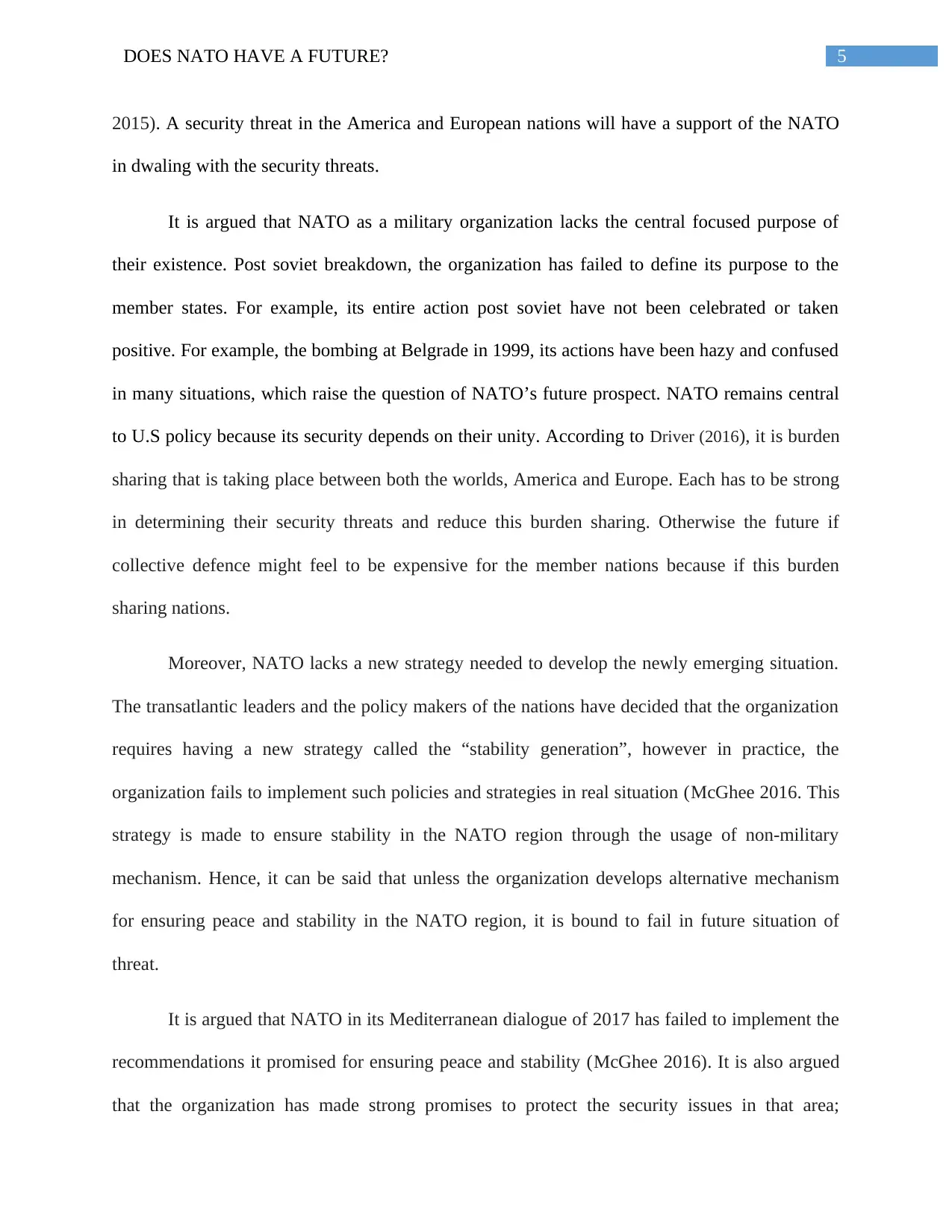
5DOES NATO HAVE A FUTURE?
2015). A security threat in the America and European nations will have a support of the NATO
in dwaling with the security threats.
It is argued that NATO as a military organization lacks the central focused purpose of
their existence. Post soviet breakdown, the organization has failed to define its purpose to the
member states. For example, its entire action post soviet have not been celebrated or taken
positive. For example, the bombing at Belgrade in 1999, its actions have been hazy and confused
in many situations, which raise the question of NATO’s future prospect. NATO remains central
to U.S policy because its security depends on their unity. According to Driver (2016), it is burden
sharing that is taking place between both the worlds, America and Europe. Each has to be strong
in determining their security threats and reduce this burden sharing. Otherwise the future if
collective defence might feel to be expensive for the member nations because if this burden
sharing nations.
Moreover, NATO lacks a new strategy needed to develop the newly emerging situation.
The transatlantic leaders and the policy makers of the nations have decided that the organization
requires having a new strategy called the “stability generation”, however in practice, the
organization fails to implement such policies and strategies in real situation (McGhee 2016. This
strategy is made to ensure stability in the NATO region through the usage of non-military
mechanism. Hence, it can be said that unless the organization develops alternative mechanism
for ensuring peace and stability in the NATO region, it is bound to fail in future situation of
threat.
It is argued that NATO in its Mediterranean dialogue of 2017 has failed to implement the
recommendations it promised for ensuring peace and stability (McGhee 2016). It is also argued
that the organization has made strong promises to protect the security issues in that area;
2015). A security threat in the America and European nations will have a support of the NATO
in dwaling with the security threats.
It is argued that NATO as a military organization lacks the central focused purpose of
their existence. Post soviet breakdown, the organization has failed to define its purpose to the
member states. For example, its entire action post soviet have not been celebrated or taken
positive. For example, the bombing at Belgrade in 1999, its actions have been hazy and confused
in many situations, which raise the question of NATO’s future prospect. NATO remains central
to U.S policy because its security depends on their unity. According to Driver (2016), it is burden
sharing that is taking place between both the worlds, America and Europe. Each has to be strong
in determining their security threats and reduce this burden sharing. Otherwise the future if
collective defence might feel to be expensive for the member nations because if this burden
sharing nations.
Moreover, NATO lacks a new strategy needed to develop the newly emerging situation.
The transatlantic leaders and the policy makers of the nations have decided that the organization
requires having a new strategy called the “stability generation”, however in practice, the
organization fails to implement such policies and strategies in real situation (McGhee 2016. This
strategy is made to ensure stability in the NATO region through the usage of non-military
mechanism. Hence, it can be said that unless the organization develops alternative mechanism
for ensuring peace and stability in the NATO region, it is bound to fail in future situation of
threat.
It is argued that NATO in its Mediterranean dialogue of 2017 has failed to implement the
recommendations it promised for ensuring peace and stability (McGhee 2016). It is also argued
that the organization has made strong promises to protect the security issues in that area;
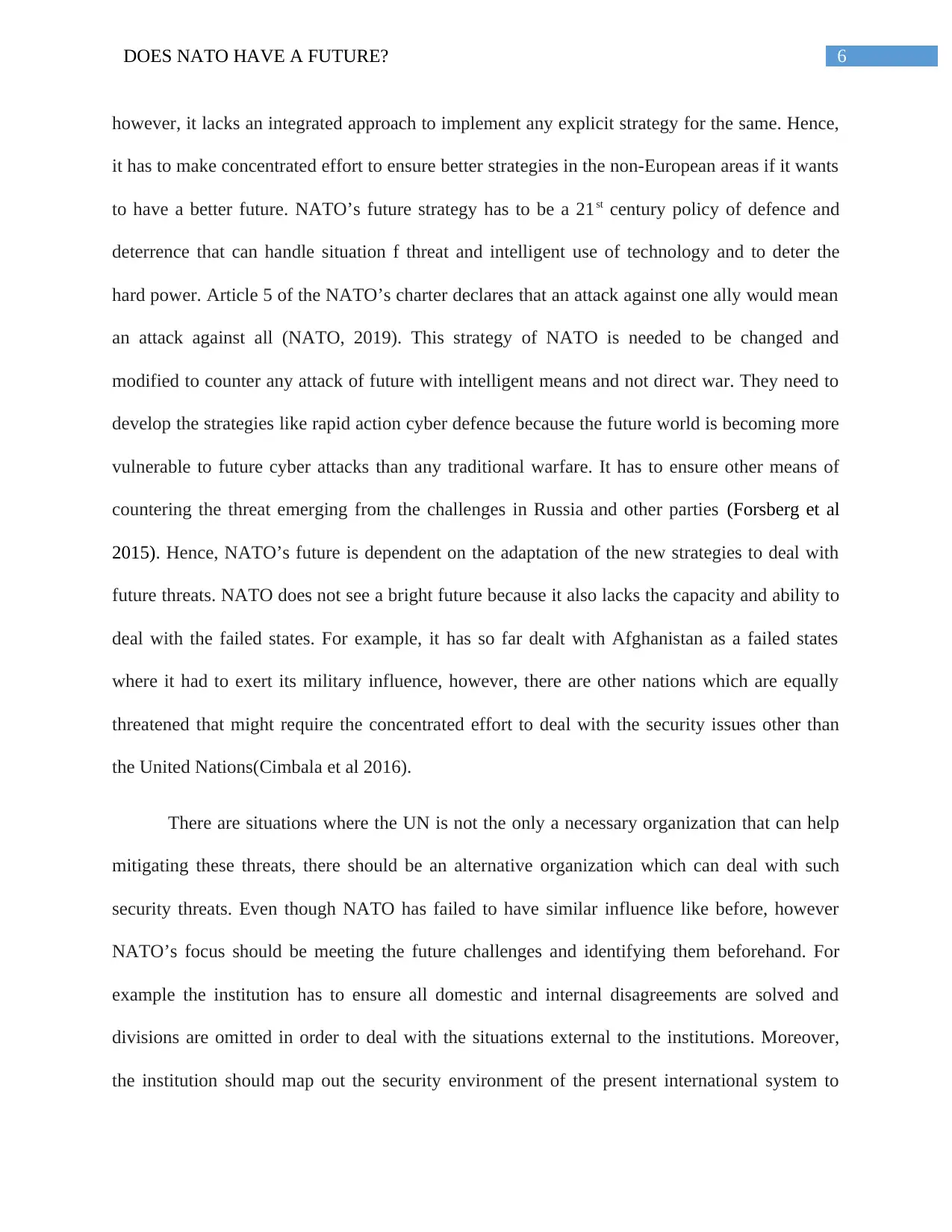
6DOES NATO HAVE A FUTURE?
however, it lacks an integrated approach to implement any explicit strategy for the same. Hence,
it has to make concentrated effort to ensure better strategies in the non-European areas if it wants
to have a better future. NATO’s future strategy has to be a 21st century policy of defence and
deterrence that can handle situation f threat and intelligent use of technology and to deter the
hard power. Article 5 of the NATO’s charter declares that an attack against one ally would mean
an attack against all (NATO, 2019). This strategy of NATO is needed to be changed and
modified to counter any attack of future with intelligent means and not direct war. They need to
develop the strategies like rapid action cyber defence because the future world is becoming more
vulnerable to future cyber attacks than any traditional warfare. It has to ensure other means of
countering the threat emerging from the challenges in Russia and other parties (Forsberg et al
2015). Hence, NATO’s future is dependent on the adaptation of the new strategies to deal with
future threats. NATO does not see a bright future because it also lacks the capacity and ability to
deal with the failed states. For example, it has so far dealt with Afghanistan as a failed states
where it had to exert its military influence, however, there are other nations which are equally
threatened that might require the concentrated effort to deal with the security issues other than
the United Nations(Cimbala et al 2016).
There are situations where the UN is not the only a necessary organization that can help
mitigating these threats, there should be an alternative organization which can deal with such
security threats. Even though NATO has failed to have similar influence like before, however
NATO’s focus should be meeting the future challenges and identifying them beforehand. For
example the institution has to ensure all domestic and internal disagreements are solved and
divisions are omitted in order to deal with the situations external to the institutions. Moreover,
the institution should map out the security environment of the present international system to
however, it lacks an integrated approach to implement any explicit strategy for the same. Hence,
it has to make concentrated effort to ensure better strategies in the non-European areas if it wants
to have a better future. NATO’s future strategy has to be a 21st century policy of defence and
deterrence that can handle situation f threat and intelligent use of technology and to deter the
hard power. Article 5 of the NATO’s charter declares that an attack against one ally would mean
an attack against all (NATO, 2019). This strategy of NATO is needed to be changed and
modified to counter any attack of future with intelligent means and not direct war. They need to
develop the strategies like rapid action cyber defence because the future world is becoming more
vulnerable to future cyber attacks than any traditional warfare. It has to ensure other means of
countering the threat emerging from the challenges in Russia and other parties (Forsberg et al
2015). Hence, NATO’s future is dependent on the adaptation of the new strategies to deal with
future threats. NATO does not see a bright future because it also lacks the capacity and ability to
deal with the failed states. For example, it has so far dealt with Afghanistan as a failed states
where it had to exert its military influence, however, there are other nations which are equally
threatened that might require the concentrated effort to deal with the security issues other than
the United Nations(Cimbala et al 2016).
There are situations where the UN is not the only a necessary organization that can help
mitigating these threats, there should be an alternative organization which can deal with such
security threats. Even though NATO has failed to have similar influence like before, however
NATO’s focus should be meeting the future challenges and identifying them beforehand. For
example the institution has to ensure all domestic and internal disagreements are solved and
divisions are omitted in order to deal with the situations external to the institutions. Moreover,
the institution should map out the security environment of the present international system to
Paraphrase This Document
Need a fresh take? Get an instant paraphrase of this document with our AI Paraphraser
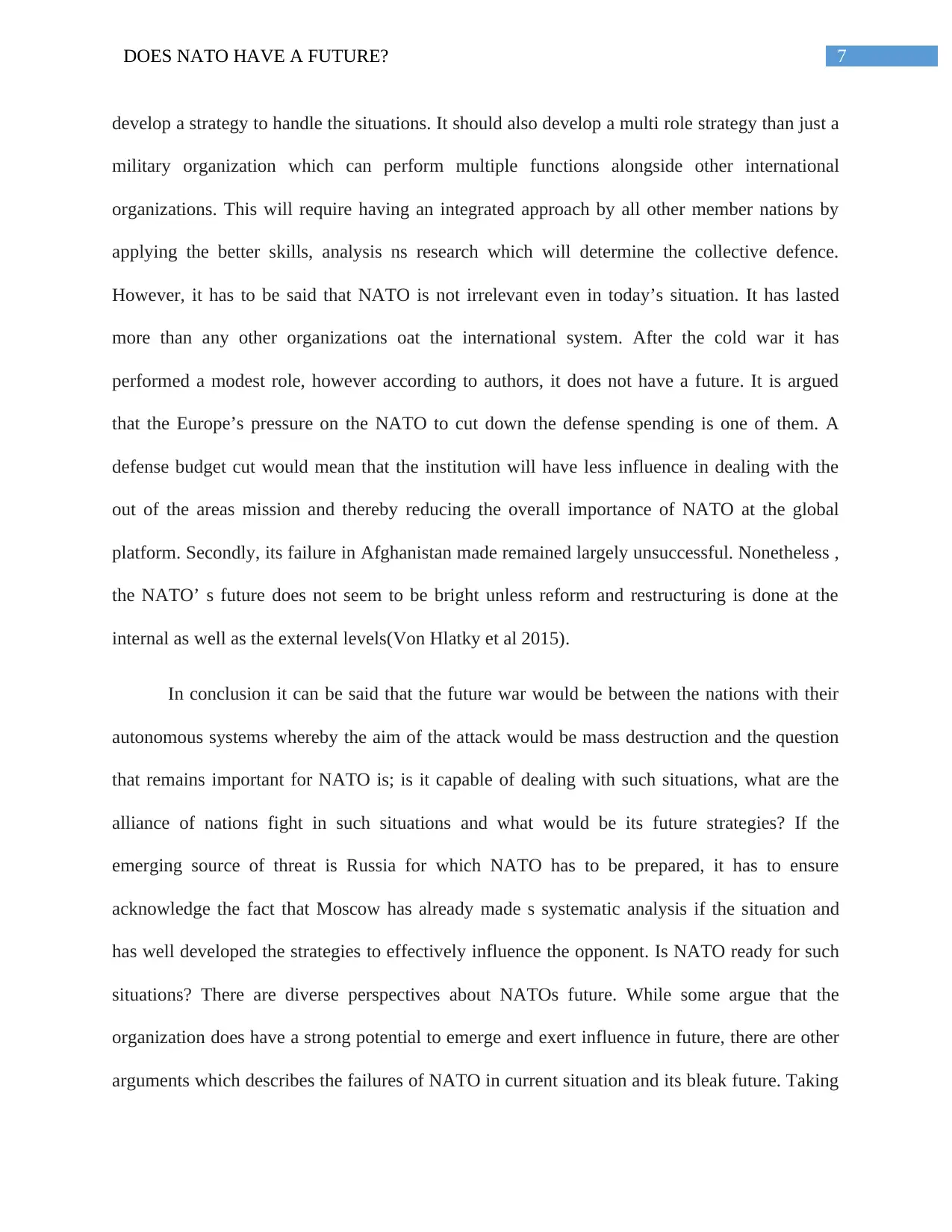
7DOES NATO HAVE A FUTURE?
develop a strategy to handle the situations. It should also develop a multi role strategy than just a
military organization which can perform multiple functions alongside other international
organizations. This will require having an integrated approach by all other member nations by
applying the better skills, analysis ns research which will determine the collective defence.
However, it has to be said that NATO is not irrelevant even in today’s situation. It has lasted
more than any other organizations oat the international system. After the cold war it has
performed a modest role, however according to authors, it does not have a future. It is argued
that the Europe’s pressure on the NATO to cut down the defense spending is one of them. A
defense budget cut would mean that the institution will have less influence in dealing with the
out of the areas mission and thereby reducing the overall importance of NATO at the global
platform. Secondly, its failure in Afghanistan made remained largely unsuccessful. Nonetheless ,
the NATO’ s future does not seem to be bright unless reform and restructuring is done at the
internal as well as the external levels(Von Hlatky et al 2015).
In conclusion it can be said that the future war would be between the nations with their
autonomous systems whereby the aim of the attack would be mass destruction and the question
that remains important for NATO is; is it capable of dealing with such situations, what are the
alliance of nations fight in such situations and what would be its future strategies? If the
emerging source of threat is Russia for which NATO has to be prepared, it has to ensure
acknowledge the fact that Moscow has already made s systematic analysis if the situation and
has well developed the strategies to effectively influence the opponent. Is NATO ready for such
situations? There are diverse perspectives about NATOs future. While some argue that the
organization does have a strong potential to emerge and exert influence in future, there are other
arguments which describes the failures of NATO in current situation and its bleak future. Taking
develop a strategy to handle the situations. It should also develop a multi role strategy than just a
military organization which can perform multiple functions alongside other international
organizations. This will require having an integrated approach by all other member nations by
applying the better skills, analysis ns research which will determine the collective defence.
However, it has to be said that NATO is not irrelevant even in today’s situation. It has lasted
more than any other organizations oat the international system. After the cold war it has
performed a modest role, however according to authors, it does not have a future. It is argued
that the Europe’s pressure on the NATO to cut down the defense spending is one of them. A
defense budget cut would mean that the institution will have less influence in dealing with the
out of the areas mission and thereby reducing the overall importance of NATO at the global
platform. Secondly, its failure in Afghanistan made remained largely unsuccessful. Nonetheless ,
the NATO’ s future does not seem to be bright unless reform and restructuring is done at the
internal as well as the external levels(Von Hlatky et al 2015).
In conclusion it can be said that the future war would be between the nations with their
autonomous systems whereby the aim of the attack would be mass destruction and the question
that remains important for NATO is; is it capable of dealing with such situations, what are the
alliance of nations fight in such situations and what would be its future strategies? If the
emerging source of threat is Russia for which NATO has to be prepared, it has to ensure
acknowledge the fact that Moscow has already made s systematic analysis if the situation and
has well developed the strategies to effectively influence the opponent. Is NATO ready for such
situations? There are diverse perspectives about NATOs future. While some argue that the
organization does have a strong potential to emerge and exert influence in future, there are other
arguments which describes the failures of NATO in current situation and its bleak future. Taking
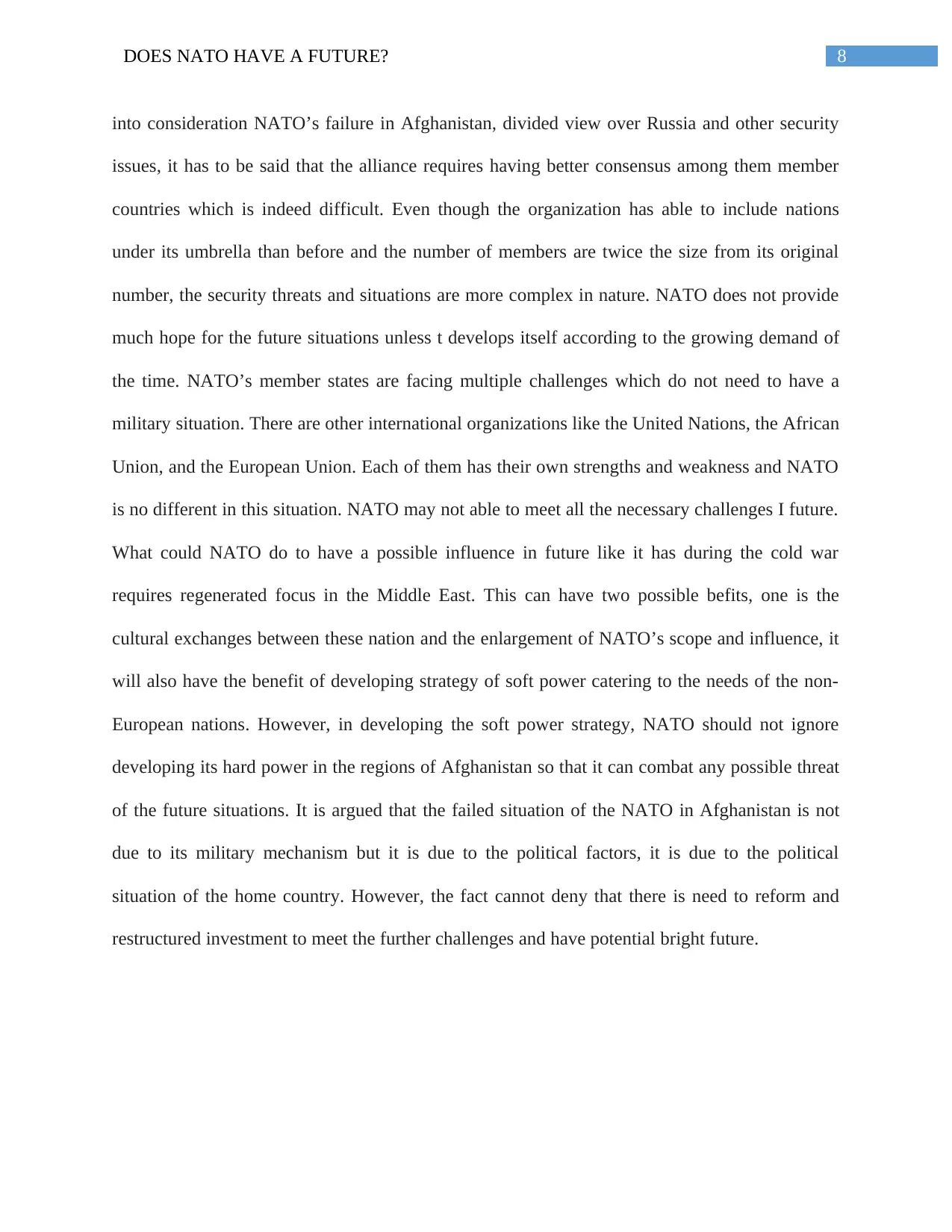
8DOES NATO HAVE A FUTURE?
into consideration NATO’s failure in Afghanistan, divided view over Russia and other security
issues, it has to be said that the alliance requires having better consensus among them member
countries which is indeed difficult. Even though the organization has able to include nations
under its umbrella than before and the number of members are twice the size from its original
number, the security threats and situations are more complex in nature. NATO does not provide
much hope for the future situations unless t develops itself according to the growing demand of
the time. NATO’s member states are facing multiple challenges which do not need to have a
military situation. There are other international organizations like the United Nations, the African
Union, and the European Union. Each of them has their own strengths and weakness and NATO
is no different in this situation. NATO may not able to meet all the necessary challenges I future.
What could NATO do to have a possible influence in future like it has during the cold war
requires regenerated focus in the Middle East. This can have two possible befits, one is the
cultural exchanges between these nation and the enlargement of NATO’s scope and influence, it
will also have the benefit of developing strategy of soft power catering to the needs of the non-
European nations. However, in developing the soft power strategy, NATO should not ignore
developing its hard power in the regions of Afghanistan so that it can combat any possible threat
of the future situations. It is argued that the failed situation of the NATO in Afghanistan is not
due to its military mechanism but it is due to the political factors, it is due to the political
situation of the home country. However, the fact cannot deny that there is need to reform and
restructured investment to meet the further challenges and have potential bright future.
into consideration NATO’s failure in Afghanistan, divided view over Russia and other security
issues, it has to be said that the alliance requires having better consensus among them member
countries which is indeed difficult. Even though the organization has able to include nations
under its umbrella than before and the number of members are twice the size from its original
number, the security threats and situations are more complex in nature. NATO does not provide
much hope for the future situations unless t develops itself according to the growing demand of
the time. NATO’s member states are facing multiple challenges which do not need to have a
military situation. There are other international organizations like the United Nations, the African
Union, and the European Union. Each of them has their own strengths and weakness and NATO
is no different in this situation. NATO may not able to meet all the necessary challenges I future.
What could NATO do to have a possible influence in future like it has during the cold war
requires regenerated focus in the Middle East. This can have two possible befits, one is the
cultural exchanges between these nation and the enlargement of NATO’s scope and influence, it
will also have the benefit of developing strategy of soft power catering to the needs of the non-
European nations. However, in developing the soft power strategy, NATO should not ignore
developing its hard power in the regions of Afghanistan so that it can combat any possible threat
of the future situations. It is argued that the failed situation of the NATO in Afghanistan is not
due to its military mechanism but it is due to the political factors, it is due to the political
situation of the home country. However, the fact cannot deny that there is need to reform and
restructured investment to meet the further challenges and have potential bright future.
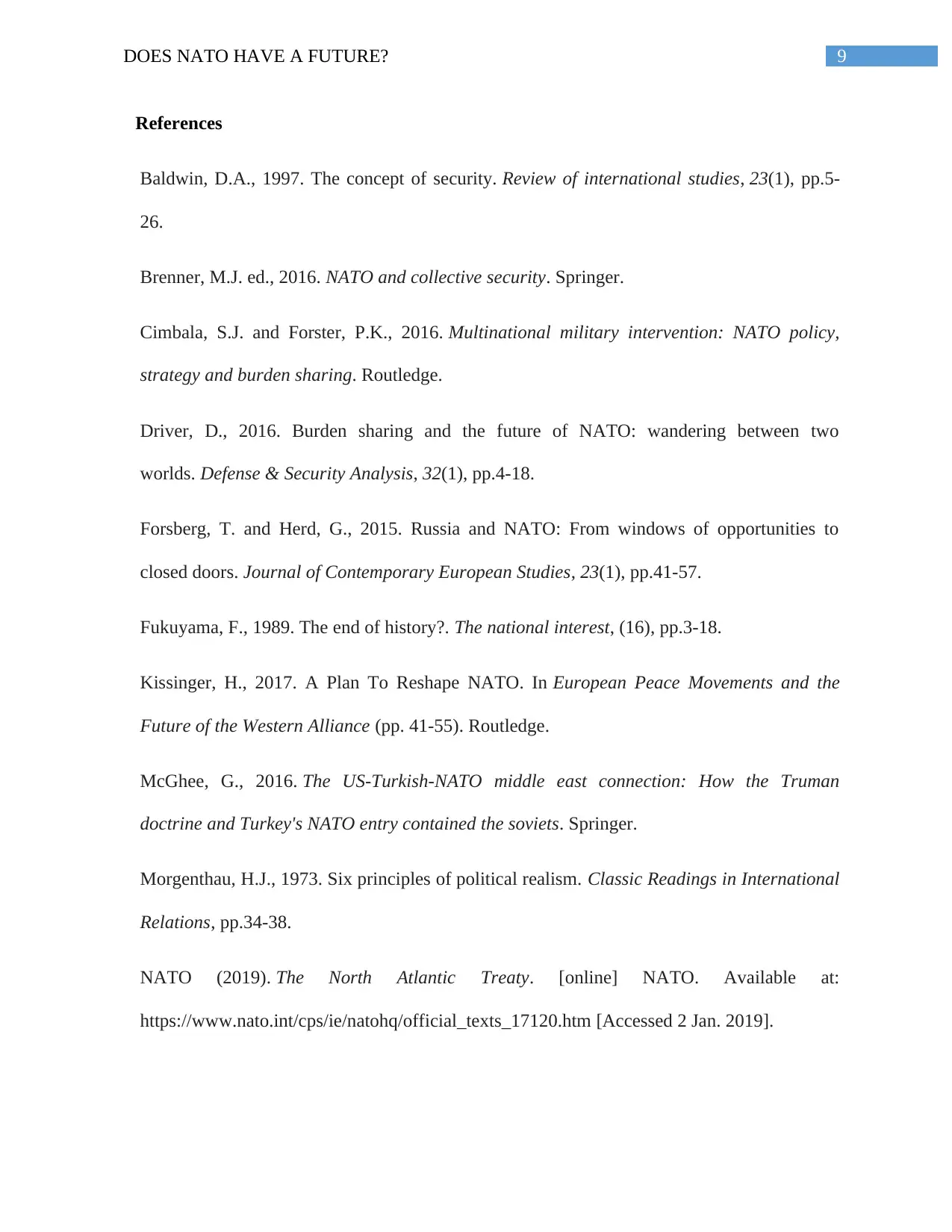
9DOES NATO HAVE A FUTURE?
References
Baldwin, D.A., 1997. The concept of security. Review of international studies, 23(1), pp.5-
26.
Brenner, M.J. ed., 2016. NATO and collective security. Springer.
Cimbala, S.J. and Forster, P.K., 2016. Multinational military intervention: NATO policy,
strategy and burden sharing. Routledge.
Driver, D., 2016. Burden sharing and the future of NATO: wandering between two
worlds. Defense & Security Analysis, 32(1), pp.4-18.
Forsberg, T. and Herd, G., 2015. Russia and NATO: From windows of opportunities to
closed doors. Journal of Contemporary European Studies, 23(1), pp.41-57.
Fukuyama, F., 1989. The end of history?. The national interest, (16), pp.3-18.
Kissinger, H., 2017. A Plan To Reshape NATO. In European Peace Movements and the
Future of the Western Alliance (pp. 41-55). Routledge.
McGhee, G., 2016. The US-Turkish-NATO middle east connection: How the Truman
doctrine and Turkey's NATO entry contained the soviets. Springer.
Morgenthau, H.J., 1973. Six principles of political realism. Classic Readings in International
Relations, pp.34-38.
NATO (2019). The North Atlantic Treaty. [online] NATO. Available at:
https://www.nato.int/cps/ie/natohq/official_texts_17120.htm [Accessed 2 Jan. 2019].
References
Baldwin, D.A., 1997. The concept of security. Review of international studies, 23(1), pp.5-
26.
Brenner, M.J. ed., 2016. NATO and collective security. Springer.
Cimbala, S.J. and Forster, P.K., 2016. Multinational military intervention: NATO policy,
strategy and burden sharing. Routledge.
Driver, D., 2016. Burden sharing and the future of NATO: wandering between two
worlds. Defense & Security Analysis, 32(1), pp.4-18.
Forsberg, T. and Herd, G., 2015. Russia and NATO: From windows of opportunities to
closed doors. Journal of Contemporary European Studies, 23(1), pp.41-57.
Fukuyama, F., 1989. The end of history?. The national interest, (16), pp.3-18.
Kissinger, H., 2017. A Plan To Reshape NATO. In European Peace Movements and the
Future of the Western Alliance (pp. 41-55). Routledge.
McGhee, G., 2016. The US-Turkish-NATO middle east connection: How the Truman
doctrine and Turkey's NATO entry contained the soviets. Springer.
Morgenthau, H.J., 1973. Six principles of political realism. Classic Readings in International
Relations, pp.34-38.
NATO (2019). The North Atlantic Treaty. [online] NATO. Available at:
https://www.nato.int/cps/ie/natohq/official_texts_17120.htm [Accessed 2 Jan. 2019].
Secure Best Marks with AI Grader
Need help grading? Try our AI Grader for instant feedback on your assignments.
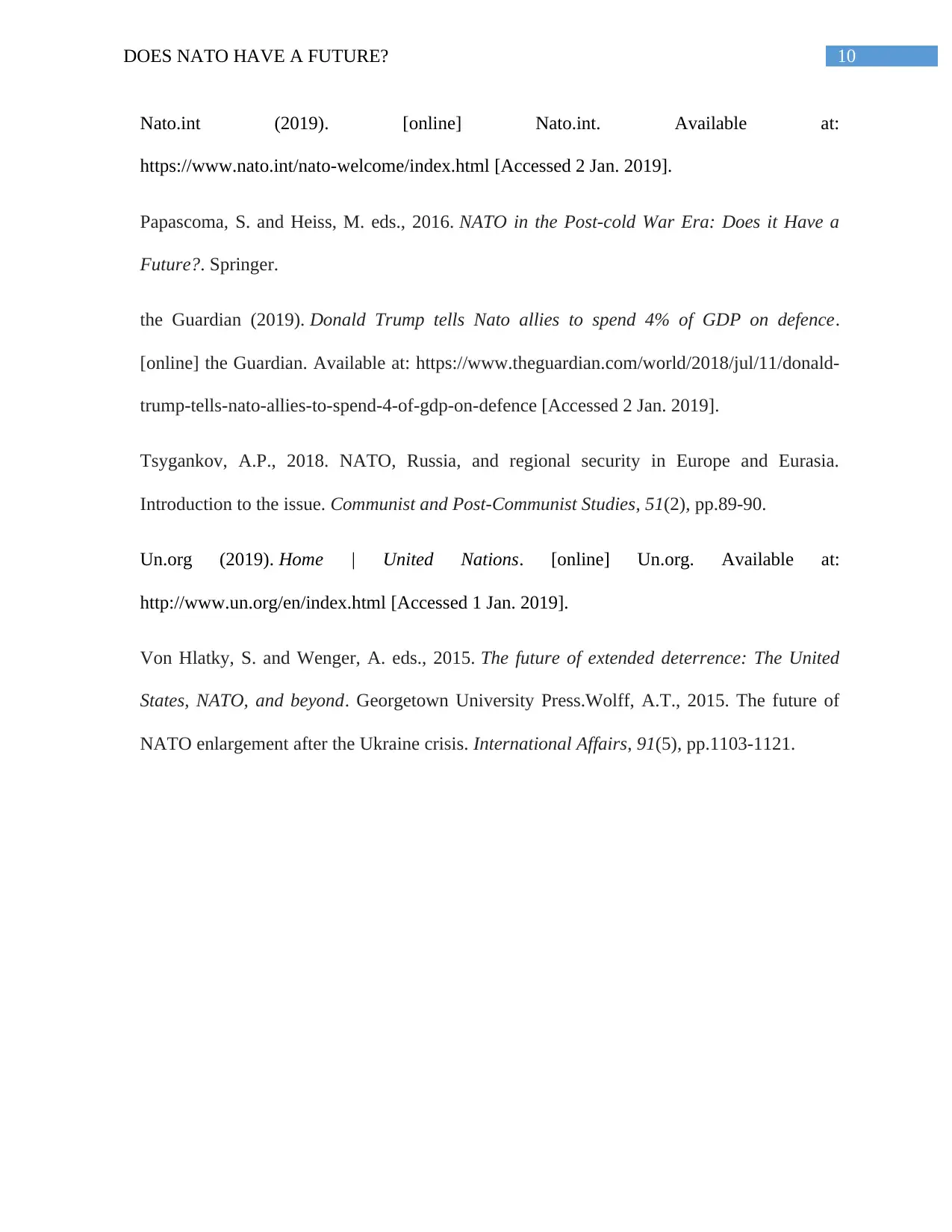
10DOES NATO HAVE A FUTURE?
Nato.int (2019). [online] Nato.int. Available at:
https://www.nato.int/nato-welcome/index.html [Accessed 2 Jan. 2019].
Papascoma, S. and Heiss, M. eds., 2016. NATO in the Post-cold War Era: Does it Have a
Future?. Springer.
the Guardian (2019). Donald Trump tells Nato allies to spend 4% of GDP on defence.
[online] the Guardian. Available at: https://www.theguardian.com/world/2018/jul/11/donald-
trump-tells-nato-allies-to-spend-4-of-gdp-on-defence [Accessed 2 Jan. 2019].
Tsygankov, A.P., 2018. NATO, Russia, and regional security in Europe and Eurasia.
Introduction to the issue. Communist and Post-Communist Studies, 51(2), pp.89-90.
Un.org (2019). Home | United Nations. [online] Un.org. Available at:
http://www.un.org/en/index.html [Accessed 1 Jan. 2019].
Von Hlatky, S. and Wenger, A. eds., 2015. The future of extended deterrence: The United
States, NATO, and beyond. Georgetown University Press.Wolff, A.T., 2015. The future of
NATO enlargement after the Ukraine crisis. International Affairs, 91(5), pp.1103-1121.
Nato.int (2019). [online] Nato.int. Available at:
https://www.nato.int/nato-welcome/index.html [Accessed 2 Jan. 2019].
Papascoma, S. and Heiss, M. eds., 2016. NATO in the Post-cold War Era: Does it Have a
Future?. Springer.
the Guardian (2019). Donald Trump tells Nato allies to spend 4% of GDP on defence.
[online] the Guardian. Available at: https://www.theguardian.com/world/2018/jul/11/donald-
trump-tells-nato-allies-to-spend-4-of-gdp-on-defence [Accessed 2 Jan. 2019].
Tsygankov, A.P., 2018. NATO, Russia, and regional security in Europe and Eurasia.
Introduction to the issue. Communist and Post-Communist Studies, 51(2), pp.89-90.
Un.org (2019). Home | United Nations. [online] Un.org. Available at:
http://www.un.org/en/index.html [Accessed 1 Jan. 2019].
Von Hlatky, S. and Wenger, A. eds., 2015. The future of extended deterrence: The United
States, NATO, and beyond. Georgetown University Press.Wolff, A.T., 2015. The future of
NATO enlargement after the Ukraine crisis. International Affairs, 91(5), pp.1103-1121.
1 out of 11
Related Documents
Your All-in-One AI-Powered Toolkit for Academic Success.
+13062052269
info@desklib.com
Available 24*7 on WhatsApp / Email
![[object Object]](/_next/static/media/star-bottom.7253800d.svg)
Unlock your academic potential
© 2024 | Zucol Services PVT LTD | All rights reserved.





